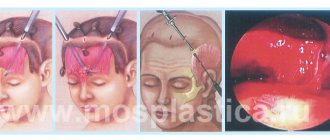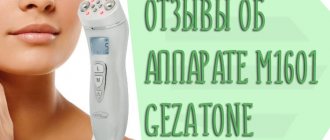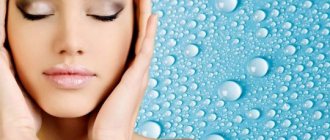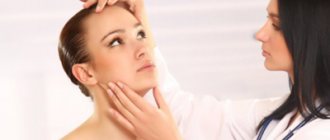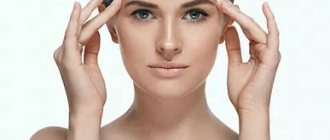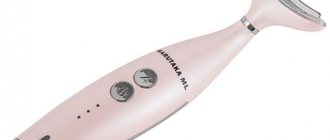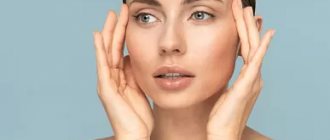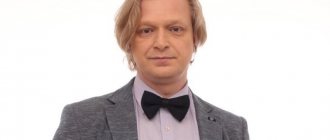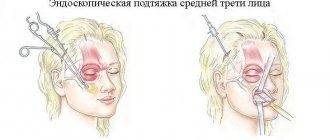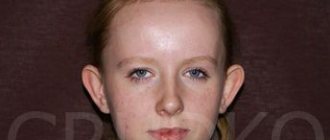Only empty, limited people do not judge by appearance. The true secret of life lies in the visible, and not in the hidden. Oscar Wilde
Why has a facelift become one of the most popular plastic surgeries today? The face is the calling card of a person. Based on it, conclusions are drawn about character, mood, approximate age and social status. However, it happens that appearance says something about a person that is not at all what he himself would like to say. Therefore, SMAS facelift has become almost a mandatory procedure for people of certain professions and standard of living. This technique can literally turn back time! A circular facelift helps not only to “throw off” 10-20 years, but to create a more optimistic and attractive image. After plastic surgery performed by Dr. Kudinova, the patient looks very natural, and the achieved effect lasts for at least 10-20 years.
Before and after SMAS facelift
All photos
Results Before and After FACIAL PLASTY Watch now
Each person and his appearance are individual: some require a circular facelift, while others need correction of individual zones. Sometimes you can get an excellent result with just a small lift of the forehead and eyebrows, or local surgical correction of the lower zone and neck.
When choosing a rejuvenation treatment, there are many factors to consider, including each patient's age, anatomy, and personal goals, vision, and expectations.
Book a consultation with Dr. Ekaterina Sergeevna Kudinova to learn more about SMAS facelift and other surgical and non-surgical rejuvenation methods. We recommend bringing your old favorite photos to your appointment.
Related video: facelift
Is a SMAS facelift right for you?
This operation can be recommended for both women and men, usually over 40 years of age. But in some cases (for example, after weight loss), facial plastic surgery can be performed at an earlier age. Anti-aging surgery may be recommended if you have one or more of the following problems:
- Visible signs of facial aging.
- Flaccid, sliding or sagging skin.
- Age-related muscle weakening.
- Change in volume and decrease in elasticity of the soft tissues of the face.
- Deep nasolabial folds.
- Changing the oval of the face.
- Wrinkles on the forehead, under the eyes, on the bridge of the nose.
- Excess fat deposits in the chin area.
- Unsightly contour of the lower jaw (“jowls”).
- Folds on the neck, double chin.
At the request of the patient and taking into account the indications and purposes of the operation, Ph.D. Ekaterina Sergeevna Kudinova can perform a facelift using an endoscopic or traditional method (more information about endoscopic facelift can be found here), as well as simultaneously with other corrections, for example, blepharoplasty, chin surgery or breast augmentation.
How is facial rejuvenation surgery performed?
There are many methods for performing this popular correction. The choice depends on the individual characteristics of the patient and his wishes. In our clinic, it is possible to carry out both an extended SMAS facelift and partial correction of individual areas, including brow lift, neck and chin plastic surgery, etc. (for reference, SMAS is the Latin abbreviation of the term PMAS - superficial muscular aponeurotic layer) .
SMAS lifting differs in the type and location of the incision:
- A classic facelift, in which incisions are made in front of the ears and along the hairline.
- An endoscopic technique is carried out through small punctures located so that they are not visible after the intervention (behind the ears, in the scalp, in the mouth, etc.).
In any case, the sutures are placed in such a way that after the end of the rehabilitation period, thin scars are completely invisible. For this purpose, the author’s “invisible seam” method of Dr. Kudinova is used. Ekaterina Sergeevna believes that one of the primary tasks of a plastic surgeon is to perform a facelift so that no visible traces of the intervention remain.
To restore the original volumes of various zones and preserve individual features, the author’s method of two-plane facial plastic surgery is used. During the operation, the doctor works with all tissues that need correction (subcutaneous lifting, SMAS lifting, deep subperiosteal lifting). In addition, Dr. Kudinova uses modern endoscopic technologies and methods of tissue fixation using endotins (special absorbable devices made of polylactic acid).
The operation is performed under general anesthesia and can last from 1 to 4 hours, depending on the complexity.
Skin care after surgery
Cosmetic and hardware procedures will help to restore the skin as quickly as possible after a facelift. They can be carried out (with the exception of physiotherapy) after the main rehabilitation period has ended. The following manipulations are allowed:
- physiotherapy – microcurrents (3-4 days after surgery), ultrasound (2-3 weeks),
- lymphatic drainage, electrostatic massage – 25-30 days after surgery;
- use of professional cosmetics (peelings) – after 2-3 months;
- injection procedures (mesotherapy, plasma therapy, Botox) – after 3-5 months.
Compliance with all rules for facial skin care, compliance with medical prescriptions, and supporting procedures is the key to quick recovery and satisfaction with the result of a facelift.
Do you need the best circular facelift surgeon in Moscow?
When it comes to such a complex and delicate area, choosing the right doctor is especially important. Plastic surgeon Ekaterina Sergeevna Kudinova is a recognized specialist in all types of aesthetic facial surgery. She has in-depth knowledge and experience in performing more than 10,000 plastic and reconstructive surgeries of various profiles. She has developed unique methods of surgical facial correction, including the technology of volumetric 2-plane facelift and the author’s “invisible seam” technology.
Plastic surgeon Kudinova uses the best experience and modern capabilities of plastic surgery to obtain maximum anti-aging effect and natural results without visible traces of surgical intervention.
A combined protocol for the use of botulinum toxin and a drug based on calcium hydroxyapatite as one of the most effective minimally invasive methods for correcting the lower third of the face.
Introduction
Almost every person pays attention to his appearance, and attaches special importance to how his face looks. Dissatisfaction in this case can become quite a serious problem and affect both the psychosomatic state (causing depression, uncertainty, neurosis), and professional status, family and personal relationships.
In aesthetic medicine, the problems of correcting the lower third of the face remain relevant. Manifestations of aging in this area are associated mainly with gravitational ptosis of soft tissues, atrophy of bone structures, functional and structural changes in the skin, subcutaneous tissue and muscles of this area. Due to changes at all anatomical levels (bones, muscles, fat and skin), the oval shape of the face loses its clear contour over the years. This creates a typical “elderly” appearance.
Meanwhile, the mandibular bone is an important component of the lower face because it is the transition area between the face and neck. And modern aesthetic cosmetology offers many options for correcting this area.
"Winning" combination
Among non-surgical methods of lifting the lower third of the face, the introduction of botulinum toxin in combination with fillers is one of the most effective, simple and affordable.
Due to the targeted redistribution of the activity of facial muscles of the face and neck, botulinum therapy allows achieving effects of improving facial contours. With its help, you can also improve the shape of a square face (by reducing the volume of the masticatory muscles against the background of their relaxation).
Injections of filler based on calcium hydroxyapatite create the opportunity to restore the appropriate volumes of the face and correct the imbalance formed by sagging areas. Of course, they cannot replace surgery, but in some patients, restoration of volume in certain anatomical areas in combination with botulinum toxin creates a rested and rejuvenated appearance.
The target muscles for aesthetic correction of the lower third of the face are:
- circular muscle of the mouth (m. orbicularis oris),
- muscle that lowers the nasal septum (depressor septinasi),
- muscles that lift the upper lip and wing of the nose (levator labii superioris aleque nasi),
- muscles that lower the angle of the mouth (depressor anguli oris, DAO),
- mental muscle (m. mentalis),
- chewing muscles (m. masseter),
- neck muscle (m. platisma).
Materials and methods
The densest fillers that can hold their shape for the maximum time are suitable for correcting this area. In my practice, I use a product based on calcium hydroxyapatite, Radiesse. This preparation allows you to obtain clear contours, eliminating the possibility of pastiness in the long term, since it does not contain components that can attract and retain water for a long time. The ability of calcium hydroxyapatite to stimulate fibroblast activity and the synthesis of new collagen also ensures a longer-lasting correction result.
Physiological mechanisms of BTA lifting
The basis of lifting the soft tissues of the face using botulinum toxin injections is an understanding of the mechanism of the muscles - levators and depressors, which are agonists or antagonists.
With age, the functional activity of depressor muscles increases under constant influence of gravity. The vectors of movement of the levator muscles are directed centrifugally - upward and outward. Over time, their tone often decreases. The vectors of movement of the depressor muscles are directed centripetally - down and inward, and their strength and activity increase with age.
When the depressor muscles relax, the skin and soft tissues of the corresponding areas rise upward due to the dominance of the levators. By varying the injection points, you can achieve optimal results.
There are many levator muscles in the lower third of the face, all of them are relatively small, so it is necessary to take into account the functional activity of the depressor muscles. Such work with muscles requires the doctor to have a good knowledge of anatomy, muscle interaction and the ability to choose the right dose. And the injection of botulinum toxin into the lower third of the face belongs to the area of risky correction.
A face with clear contours looks less aged because it has more solid mandibular support and good bone structure counteracts skin ptosis. This fact became the basis for deep - at the level of the periosteum - injection of fillers. Today, this technique allows you to increase the projection of the lower jaw and chin.
Conclusion
To carry out combined protocols for the use of botulinum toxin and a drug based on calcium hydroxyapatite, careful selection of patients, mastery of a certain administration technique and, of course, medical experience are required. In this case, a minimally invasive – “Hollywood” – facial contour correction procedure will give a beautiful aesthetic result.
Author: N atalya Kon-Fan-San, dermatologist, cosmetologist, Moscow.
Magazine: Appearance. Esthetic guide №3(31)
How much does it cost to get a facelift in Moscow?
The price of the operation depends on the level of the specialist, the conditions of the clinic in which the correction is performed, and the medications used. The price for a circular facelift in Moscow varies widely.
The best methods, the best drugs, the best rehabilitation conditions determine the current prices for facial plastic surgery, which cannot be too low. However, Dr. Kudinova believes that the best balance of high quality surgery and reasonable prices for plastic surgery is in the interests of patients and the surgeon himself.
To learn more about surgical facelift operations and other rejuvenation procedures, sign up for a consultation with Ekaterina Sergeevna Kudinova through the online registration form or by calling +7 (495) 53-23-911 or +7 (903) 790-69-58
Summary
As I said at the beginning of the article: any manipulation of your body requires subsequent recovery. In some cases it means a day or two of rest, in others it means several months of restrictions. It is important to remember a number of general points:
- Strictly follow the specialist's recommendations.
- Tell your specialist about anything that is causing you concern.
- Monitor your health carefully.
- Refrain from sunbathing, solariums and baths.
- Give yourself a break from physical activity.
- Don't worry if you don't see the desired changes in the mirror the next day after the procedure.
